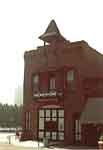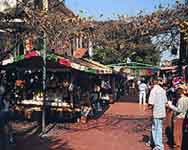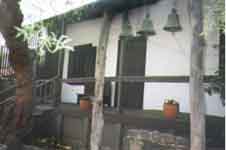| |
Aaron's Tour of Los
Angeles - Part 1
El Pueblo Historic District, New Downtown,
and Hollywood

|
A.
OVERVIEW
The tour begins in the "El Pueblo"
historic area, which is where the city first began as a
small town about 1781. After a short ride on the MTA Red
Line (yes, L.A. does have a subway system in part of the
city and you can ride it for just $1.35), the tour continues
in the "New Downtown" area. After another short
ride on the Metro, the tour continues in Hollywood.
|
|
B.
DRIVING AND PARKING
Note: These directions were taken from another
source and have not yet been tested.
1. From the North: Drive toward Downtown
on the Pasadena Freeway (110) and take the transition ramp
to the 101 East. Almost immediately, take the exit marked
Broadway but continue two blocks to Main. Turn left onto
Main Street. Parking lots are on the left side of Main Street.
2. From the East: Take the Santa Ana Freeway.
Exit at Alameda Street. Turn right and drive north on Alameda
to Cesar Chavez Avenue. Turn left onto Cesar Chavez Avenue
and left again on Spring Street. Parking lots are on the
left side of Spring Street heading south.
3. From the South and West: Drive north on
the Harbor Freeway (110). Take the transition ramp to the
101 East. Almost immediately, take the exit marked Broadway
but continue two blocks to Main Street. Turn left onto Main.
Parking lots are on the left side of Main Street.
4. From the Northwest (Hollywood and San
Fernando Valley): Take the Hollywood Freeway (101 East)
to the exit marked Broadway but continue two blocks to Main
Street. Turn left onto Main. Parking lots are on the left
side of Main Street.
|
| C.
EL PUEBLO HISTORIC DISTRICT |
 |
Los
Angeles was founded about September 4, 1781 when 44 settlers
arrived from Northern Mexico. King Carlos III of Spain ordered
Felipe de Neve, then governor of Baja and Alta California,
to recruit these settlers to raise food for the soldiers who
were protecting Spanish territory. The city was named "El
pueblo de la reina de los angeles sobre el rió de la
porciúncula" (The town of the queen of the angles
near the porciúncula river). "Porciúncula"
is a Spanish holiday, and the river was discovered during
this holiday. "Porciuncala" refers to a little plot
of land next to the church in Assisi, Italy where St. Francis
of Assisi had lived and worshipped. He established the order
of Spanish padres who founded the missions in the Americas. |
|
1. Old Plaza
The "Old Plaza," at one end of
Olvera Street was the first central gathering spot in the
city of Los Angeles. The city was composed of numerous small
farms and families would travel to the old plaza in order
to attend church at the old Plaza Catholic Church, watch
bullfights in the plaza, and other special events. As the
town grew, retired soldiers petitioned for and were granted
the use of large tracts of land to graze cattle. Only thirteen
such "Spanish land grants" were made in Los Angeles
County before Mexico declared its independence from Spain
in 1821. Mexican independence is celebrated along with U.S.
independence in Los Angeles, and there is replica of the
Bell of Delores just off of Olvera Street. The old plaza
is also home to the first fire station in Los Angeles and
the Pico House, the first grand hotel in the area.
|
|
2. Firehouse
No. 1
 In 1869, almost 100 years after the
founding of the city, the citizens decided to create a volunteer
fire department. The city created a committee to assist
the volunteer fire department and installed hydrants to
supply water. Two years later, a fire department was created
and a full time employee, George P. McClain, was hired as
the first engineer at a salary of $100 per month. A steam
fire engine and hose cart were purchased, but the volunteers
resigned a year later when the council refused to buy a
pair of horses to pull the fire engine. In 1874 a new volunteer
company was formed with 38 members, known as the Volunteer
38's. Their foreman, Charles E. Miles, was given the fire
engine and he persuaded the council to purchase a pair of
horses. A second volunteer company was created and known
as Confidence No. 2. The volunteer companies were arch rivals
and competed to see who could arrive first at the scene
of a fire. In 1869, almost 100 years after the
founding of the city, the citizens decided to create a volunteer
fire department. The city created a committee to assist
the volunteer fire department and installed hydrants to
supply water. Two years later, a fire department was created
and a full time employee, George P. McClain, was hired as
the first engineer at a salary of $100 per month. A steam
fire engine and hose cart were purchased, but the volunteers
resigned a year later when the council refused to buy a
pair of horses to pull the fire engine. In 1874 a new volunteer
company was formed with 38 members, known as the Volunteer
38's. Their foreman, Charles E. Miles, was given the fire
engine and he persuaded the council to purchase a pair of
horses. A second volunteer company was created and known
as Confidence No. 2. The volunteer companies were arch rivals
and competed to see who could arrive first at the scene
of a fire.
Firehouse No. 1 was built in September 1884
because the 38's rented quarters were leaking badly. The
building was designed with a turntable in the floor, so
that the horses would not have to back in or out. Walter
S. Moore, popular head of Confidence No. 2 was elected Chief
Engineer of the volunteer firemen. Moore was elected to
the city council in 1882 and became head of the Committee
on Fire and Water. He played an instrumental role in raising
funds for Firehouse No. 1. Due to bickering amongst the
different fire companies, the city established a paid fire
department in December of 1885.
|
|
3. Pico House
 Built in 1869, Pio Pico, the last Mexican governor
of California built the Pico House, a luxurious hotel, and
the first three story building in the city in an attempt
to revitalize the old plaza area. He sold his land in the
San Fernando Valley in order to fund the project. A french
restaurant used to be housed in the hotel and when the hotel
is restored, a french restaurant will once again reside
within the Pico House. Built in 1869, Pio Pico, the last Mexican governor
of California built the Pico House, a luxurious hotel, and
the first three story building in the city in an attempt
to revitalize the old plaza area. He sold his land in the
San Fernando Valley in order to fund the project. A french
restaurant used to be housed in the hotel and when the hotel
is restored, a french restaurant will once again reside
within the Pico House.
|
| 4.
Olvera Street
 Olvera Street was one of the oldest
streets in the city and was originally known as Vine or
Wine street (early maps and manuscripts mention both names).
It was located on the north side of the Plaza and ended
in a bluff above the zanja madre ("mother ditch")
that provided water for the city. In 1846 the Mexican-American
War began and U.S. forces occupied Los Angeles the following
year. The Avila Adobe was occupied by Commodore Robert F.
Stockton and used as his headquarters as peace was negotiated
between the Californians and the American authorities. Olvera Street was one of the oldest
streets in the city and was originally known as Vine or
Wine street (early maps and manuscripts mention both names).
It was located on the north side of the Plaza and ended
in a bluff above the zanja madre ("mother ditch")
that provided water for the city. In 1846 the Mexican-American
War began and U.S. forces occupied Los Angeles the following
year. The Avila Adobe was occupied by Commodore Robert F.
Stockton and used as his headquarters as peace was negotiated
between the Californians and the American authorities.
In 1877 the City Council renamed the street
after Agustin Olvera, the first judge of the County of Los
Angeles. The oldest building in the city, the Avila Adobe
(built by former mayor, Francisco Avila in 1818) is located
on Olvera Street, as is the Pelanconi House (one of four
structured erected by Italians on Olvera Street and the
oldest brick building in the city). In 1903, a large power
substation was built between Los Angeles and Olvera Streets
to provide electricity for the city's trolley cars. In 1926,
Christine Sterling fought to revitalize Olvera Street and
save the Avila Adobe from demolition. Along with such friends
as Harry Chandler, publisher of the Los Angeles Times, Mrs.
Sterline began the revitalization process which culminated
in an ordinance passed by the City Council in 1929 that
closed Olvera Street to traffic and for use as a Mexican
market place. The street has been home to wide range of
people, including the 1932 olympic team from Mexico to U.S.
soldiers during World War II. In the 1930's, Olvera Street
was popular with film stars, including Charlie Chaplin,
Douglas Fairbanks, and Gretta Garbo. Albert Einstein, John
F. Kennedy, and Eleanor Roosevelt have also visited the
street.
|
5.
Avila Adobe
 The Avilla Adobe, the oldest residence in Los
Angeles, was constructed about 1818 as the home of Francisco
Avilla, alcalde (mayor) of the city. Only this seven room
wing remains of what was once eighteen rooms, the finest residence
in the city. It is constructed of adobe brick over cottonwood
timbers taken from the banks of the Los Angeles River. The
walls are almost three feet thick. The floor, originally packed
earth, is planked. The building was severely damaged in the
earthquakes of 1870, 1857, and 1971 but has been restored.
The building was abandoned by Senora Avilla during the American
occupation of Los Angeles. Commodore Robert Stockton, commander
of the U.S. Pacific Fleet, used the structure as his headquarters
for a brief time during the Mexican-American War. After his
departure Senora Avilla returned to her home, where she lived
until her death in 1855. The Avilla Adobe, the oldest residence in Los
Angeles, was constructed about 1818 as the home of Francisco
Avilla, alcalde (mayor) of the city. Only this seven room
wing remains of what was once eighteen rooms, the finest residence
in the city. It is constructed of adobe brick over cottonwood
timbers taken from the banks of the Los Angeles River. The
walls are almost three feet thick. The floor, originally packed
earth, is planked. The building was severely damaged in the
earthquakes of 1870, 1857, and 1971 but has been restored.
The building was abandoned by Senora Avilla during the American
occupation of Los Angeles. Commodore Robert Stockton, commander
of the U.S. Pacific Fleet, used the structure as his headquarters
for a brief time during the Mexican-American War. After his
departure Senora Avilla returned to her home, where she lived
until her death in 1855. |
|
6. Union
Station
 As the western terminus for the Southern Pacific,
Union Pacific, and Santa Fe lines, Union Station was built
in 1939 to provide access to 16 tracks along with a large
parking area. The building has been restored to its original
beauty and is one of the last railroad monuments in the
country still in operation. It has a 135 foot high observation
and clock tower, a 52-foot-ceiling, marble floor and comfortable
old-fashioned leather armchairs. The building mixes two
architectural styles Spanish Colonial Revival and
Art Deco and has recently been expanded to include
access to the new MTA, and the MTA headquarters. The mission
is located where China Town was originally located, as was
part of the Porciúncula River, which has been moved
and renamed as the Los Angeles River. Be sure to walk through
the long path to the other end of Union Station, where you
can go up the escalator and out to the new MTA building,
see an artistic tribute to the old Chinatown, and catch
the MTA. As the western terminus for the Southern Pacific,
Union Pacific, and Santa Fe lines, Union Station was built
in 1939 to provide access to 16 tracks along with a large
parking area. The building has been restored to its original
beauty and is one of the last railroad monuments in the
country still in operation. It has a 135 foot high observation
and clock tower, a 52-foot-ceiling, marble floor and comfortable
old-fashioned leather armchairs. The building mixes two
architectural styles Spanish Colonial Revival and
Art Deco and has recently been expanded to include
access to the new MTA, and the MTA headquarters. The mission
is located where China Town was originally located, as was
part of the Porciúncula River, which has been moved
and renamed as the Los Angeles River. Be sure to walk through
the long path to the other end of Union Station, where you
can go up the escalator and out to the new MTA building,
see an artistic tribute to the old Chinatown, and catch
the MTA.
|
|
7. MTA Building
 This high-rise is the new home to the Metropolitan
Transit District. It has been linked to Union Station to
form a collective hub for commuter rail traffic and the
terminus of the Red Line Subway. The $300 million, 26 story
MTA building features Italian granite, English brick, and
a $300,000 aquarium. This high-rise is the new home to the Metropolitan
Transit District. It has been linked to Union Station to
form a collective hub for commuter rail traffic and the
terminus of the Red Line Subway. The $300 million, 26 story
MTA building features Italian granite, English brick, and
a $300,000 aquarium.
|
|
TRANSITION
 Take the
MTA Red Line from Union Station to Pershing Square, where
the "New Downtown" part of the tour begins. (Click
here
or on the subway to continue the tour) Take the
MTA Red Line from Union Station to Pershing Square, where
the "New Downtown" part of the tour begins. (Click
here
or on the subway to continue the tour)
|
|
|
|